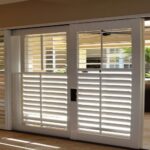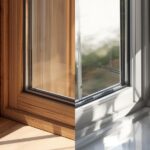Choosing between sliding doors and bifold doors can transform your living space dramatically. Moreover, whether you’re renovating your patio entrance, updating bifold closet doors, or creating a seamless indoor-outdoor flow, understanding the key differences will help you make the right investment for your home.
Furthermore, both door styles offer unique advantages, yet they serve different purposes and aesthetic preferences. Additionally, this comprehensive comparison will explore everything from sliding doors vs bifold doors cost to functionality, helping you determine which option aligns best with your lifestyle and budget.
Understanding Sliding Doors: Sleek and Space-Efficient
Sliding doors operate on a simple yet effective mechanism. Specifically, these doors feature large glass panels that glide horizontally along a track system, with one panel sliding behind another. Consequently, this space-saving functionality makes them particularly appealing for homes with limited floor space.
Key Features of Sliding Door Systems
The design philosophy behind sliding doors centers on minimalism and efficiency. Unlike traditional hinged doors, they don’t require additional clearance space when opening, making them ideal for tight areas. Multi sliding patio doors can incorporate three, four, or even more panels, creating expansive openings while maintaining their streamlined operation.
Most sliding door systems feature narrow sightlines and minimal frame profiles, maximizing your view of the outdoors. This characteristic becomes particularly valuable when the doors remain closed, as the unobstructed views enhance the sense of space and natural light penetration.
The thermal efficiency of modern sliding doors has improved significantly. Advanced weather sealing and double or triple-glazing options ensure excellent insulation performance, rivaling traditional door systems while maintaining their sleek aesthetic appeal.
Exploring Bifold Doors: Maximum Opening and Flexibility
Bifold doors operate on an accordion-like principle, with multiple panels connected by hinges that fold against each other when opened. This mechanism allows them to create remarkably wide openings, often exposing up to 90% of the available wall space.
The Accordion Advantage
When considering bifold or french doors, bifold systems offer superior flexibility in opening configurations. You can choose to open just one panel for everyday access or fold back the entire system for entertaining guests. This versatility makes them particularly attractive for homeowners who value adaptability.
The panoramic views achieved when bifold doors are fully open create an almost seamless transition between indoor and outdoor spaces. This feature has made them increasingly popular in modern architectural designs that emphasize indoor-outdoor living concepts.
Bifold closet doors operate on the same principle but are designed for interior applications. However, they share the space-saving benefits with their exterior counterparts, requiring minimal clearance compared to traditional hinged doors.
Sliding Doors vs Bifold Doors Cost: Breaking Down the Investment
Initial Purchase Price
The sliding doors vs bifold doors price comparison reveals several important considerations. For smaller openings, both systems typically cost between $500 to $2,500 for residential applications. However, as opening sizes increase, the cost dynamics change significantly.
Sliding doors with larger glass panels can become expensive due to the size and weight of individual glass units. Conversely, bifold doors may cost more due to their complex hardware systems and multiple moving parts, despite using smaller individual glass panels.
Installation Considerations
Professional installation is crucial for both systems, but bifold doors typically require more specialized expertise. The precision needed to align multiple panels and ensure smooth operation often results in higher installation costs. Meanwhile, sliding doors generally have more straightforward installation requirements.
Long-term Value Analysis
When evaluating pros and cons of bifold closet doors or patio applications, consider the long-term value proposition. Both systems can increase property value, but the return on investment varies based on your specific application and local market preferences.
Sliding Doors vs Bifold Doors Pros and Cons: Detailed Comparison
Sliding Doors Advantages
The primary strength of sliding doors lies in their consistent performance and minimal maintenance requirements. Their sleek design appeals to homeowners seeking clean, modern aesthetics without compromising functionality.
Space efficiency remains their most significant advantage. Since panels slide parallel to the wall, they don’t require additional floor space when opened, making them perfect for patios with limited depth or areas where furniture placement is crucial.
The narrow frame profiles of quality sliding systems maximize glass area, resulting in excellent views even when closed. This feature particularly benefits homes where the doors remain closed frequently, as occupants still enjoy unobstructed outdoor views.
Sliding Doors Limitations
The main limitation of sliding doors involves their opening configuration. Traditional systems can only open approximately 50-65% of the available space, as one panel must always remain in place. While multi sliding patio doors can improve this ratio, they still cannot achieve the complete opening possible with bifold systems.
Accessibility can also present challenges, particularly for wheelchair users or individuals with mobility limitations. The track system and threshold requirements may create barriers that bifold systems can more easily accommodate.
Bifold Doors Advantages
The uninterrupted panoramic views when fully opened represent the primary advantage of bifold doors. This capability transforms living spaces, creating a genuine indoor-outdoor connection that’s impossible to achieve with other door types.
Accessibility features make bifold systems particularly appealing for universal design applications. The ability to create level thresholds and wider openings accommodates wheelchairs and eliminates tripping hazards effectively.
Customization options for bifold systems are extensive. From color choices to hardware selections and operation configurations, these doors can be tailored to match virtually any architectural style or personal preference. When working with experienced suppliers like those specializing in premium aluminum door systems, you can explore countless design possibilities that complement your home’s unique character.
Bifold Doors Challenges
The complexity of bifold doors can create maintenance challenges. Multiple hinges and moving parts require regular attention to ensure smooth operation. Additionally, the drainage issues that can occur with some installations need professional attention to prevent water infiltration problems.
Cost considerations extend beyond initial purchase price. The specialized hardware and professional installation requirements often result in higher overall project costs compared to sliding alternatives.
Double Sliding Doors vs Bifold Doors: Specific Applications
Patio Applications
For patio installations, the choice between double sliding doors and bifold doors often depends on your entertainment style and space constraints. Bifold systems excel when you regularly host gatherings and want to create seamless indoor-outdoor flow.
Double sliding doors work better for homes where the doors primarily remain closed, as their superior views when shut enhance daily living comfort. They also suit properties with limited patio depth where folded bifold panels might obstruct outdoor space.
Interior Applications
Bifold closet doors offer advantages in bedroom and storage applications where maximizing access is important. They allow full access to closet contents while requiring minimal clearance space compared to hinged alternatives.
Sliding doors for interior applications, such as room dividers or closets, provide consistent operation with minimal maintenance requirements. Their smooth operation and space-saving design make them suitable for high-traffic areas. Professional installation of high-quality sliding door hardware ensures years of reliable performance in these demanding environments.
Panoramic Doors vs Bifold: Exploring Premium Options
Panoramic doors represent a premium category that can include both sliding and bifold configurations. These systems focus on maximizing glass area and minimizing frame visibility to create exceptional views and light penetration.
When comparing panoramic doors vs bifold systems specifically, consider that panoramic sliding doors can achieve remarkable views when closed but limited opening capability. Conversely, panoramic bifold doors provide both excellent closed-door views and complete opening capability, though at higher cost and complexity.
Sliding Doors vs French Doors: Alternative Considerations
While focusing on the sliding doors vs bifold doors comparison, it’s worth noting that sliding doors vs french doors presents another viable option. French doors offer traditional aesthetic appeal and familiar operation but require significant clearance space and typically provide smaller openings than either sliding or bifold alternatives.
The choice between these options often comes down to architectural style preferences, space constraints, and desired opening size rather than pure functionality considerations.
Thermal Performance and Energy Efficiency
Thermal insulation varies significantly between sliding and bifold door systems. Sliding doors often provide superior thermal efficiency due to their simpler sealing mechanisms and fewer potential air leakage points. However, bifold doors with multiple panels may have more frame connections that can impact thermal performance.
Double-glazed or triple-glazed options are available for both systems, significantly improving energy efficiency. Weather stripping and thermal breaks in the frame construction play crucial roles in overall performance. When evaluating energy-efficient door solutions, consider both the glazing specifications and frame construction details.
Acoustic insulation also differs between systems. Sliding doors typically offer better sound insulation due to their continuous sealing around the perimeter. Bifold doors may allow more sound transmission through their hinge points and panel connections.
Security Features and Locking Mechanisms
Security considerations vary significantly between sliding and bifold door systems. Sliding doors traditionally offer single-point locking, though modern systems can incorporate multi-point locking mechanisms for enhanced security.
Bifold doors typically feature multiple locking points at each hinge or frame connection, potentially providing superior security. The multiple panels create more locking opportunities, making unauthorized entry more difficult.
Anti-lift devices, security bars, and reinforced glass options are available for both systems. The choice often depends on your specific security requirements and the level of protection desired for your property.
Maintenance Requirements and Durability
Maintenance needs differ considerably between sliding and bifold door systems. Sliding doors require regular track cleaning and roller maintenance but generally have fewer moving parts to service.
Bifold doors need attention to multiple hinges, pivot points, and panel alignment. However, individual panel replacement is often easier with bifold systems compared to sliding door panels.
Weather resistance depends largely on material selection and installation quality. Aluminum frames offer excellent durability and weather resistance for both systems. Professional maintenance services from experienced providers ensure optimal performance and longevity, extending the life of your investment in premium door systems.
Making Your Decision: Practical Considerations
Space Assessment
Begin your decision process by carefully measuring your available space, both interior and exterior. Consider not only the opening width but also the depth available for door operation. Bifold doors require adequate space for panel stacking, while sliding doors need consideration for panel overlap areas.
Usage Patterns
Honestly evaluate how you’ll use your doors. If you entertain frequently and want maximum opening capability, bifold doors provide superior performance. However, if the doors will remain closed most of the time, sliding doors may offer better daily satisfaction through their superior views.
Budget Planning
Consider both immediate costs and long-term expenses. While initial purchase prices may be similar for smaller openings, factor in installation complexity, maintenance requirements, and potential repair costs when making your decision.
Climate Considerations
Your local climate impacts door performance significantly. Areas with severe weather may benefit from the superior weather sealing possible with sliding doors, while temperate climates can take full advantage of bifold doors’ opening capabilities.
Professional Installation and Quality Considerations
Regardless of your choice between sliding doors and bifold doors, professional installation is essential for optimal performance. Quality installation ensures proper weatherproofing, smooth operation, and longevity that justifies your investment.
When selecting a supplier and installer, look for companies with specific experience in your chosen door type. Aluminum doors, in particular, require expertise in proper sealing and thermal break installation to achieve their full performance potential.
The quality of hardware components significantly impacts long-term satisfaction with either door type. Investing in premium tracks, hinges, and locking mechanisms pays dividends through years of reliable operation and reduced maintenance requirements.
The Bottom Line!
The sliding doors vs bifold doors decision ultimately depends on your specific priorities, space constraints, and lifestyle preferences. Sliding doors excel in providing consistent views, minimal maintenance, and space efficiency, making them ideal for daily comfort and smaller spaces.
Bifold doors shine when maximum opening capability, accessibility, and indoor-outdoor integration take priority. Their ability to transform spaces makes them particularly valuable for entertainment-focused homeowners and contemporary architectural designs.
Both options can enhance your home’s value and comfort when properly selected and installed. Consider consulting with door specialists who can evaluate your specific situation and recommend the optimal solution for your unique requirements.
The investment in quality doors, whether sliding or bifold, pays long-term dividends through enhanced comfort, energy efficiency, and property value. Take time to carefully evaluate your needs, space constraints, and budget to make the choice that will provide years of satisfaction and performance.





